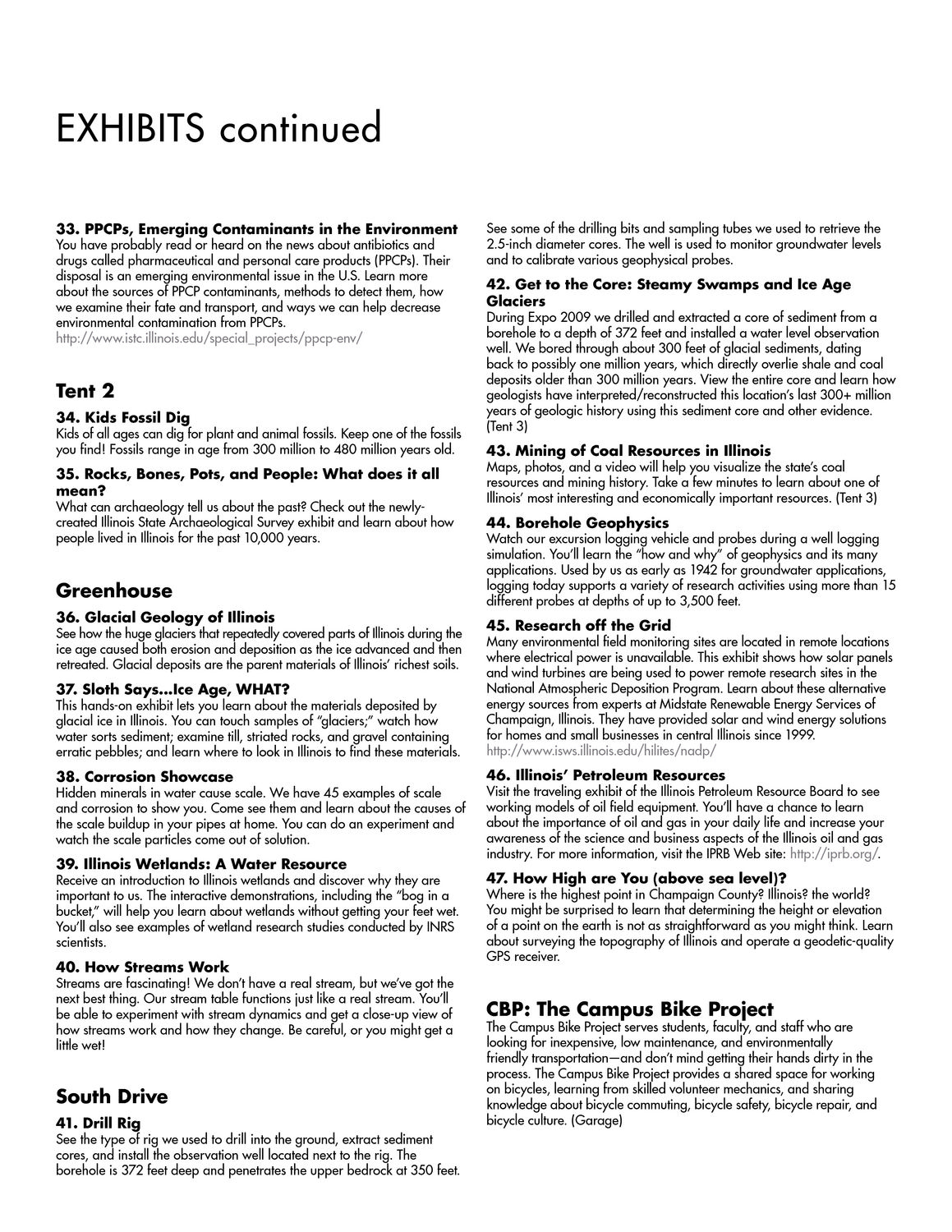Caption: IRNS Open House Guide - 2010
This is a reduced-resolution page image for fast online browsing.

EXTRACTED TEXT FROM PAGE:
ExHIBITS continued 33. PPCPs, emerging Contaminants in the environment You have probably read or heard on the news about antibiotics and drugs called pharmaceutical and personal care products (PPCPs). Their disposal is an emerging environmental issue in the U.S. Learn more about the sources of PPCP contaminants, methods to detect them, how we examine their fate and transport, and ways we can help decrease environmental contamination from PPCPs. http://www.istc.illinois.edu/special_projects/ppcp-env/ See some of the drilling bits and sampling tubes we used to retrieve the 2.5-inch diameter cores. The well is used to monitor groundwater levels and to calibrate various geophysical probes. 42. get to the Core: Steamy Swamps and ice age glaciers Tent 2 34. Kids Fossil dig Kids of all ages can dig for plant and animal fossils. Keep one of the fossils you find! Fossils range in age from 300 million to 480 million years old. During Expo 2009 we drilled and extracted a core of sediment from a borehole to a depth of 372 feet and installed a water level observation well. We bored through about 300 feet of glacial sediments, dating back to possibly one million years, which directly overlie shale and coal deposits older than 300 million years. View the entire core and learn how geologists have interpreted/reconstructed this location’s last 300+ million years of geologic history using this sediment core and other evidence. (Tent 3) 43. Mining of Coal Resources in illinois 35. Rocks, Bones, Pots, and People: What does it all mean? What can archaeology tell us about the past? Check out the newlycreated Illinois State Archaeological Survey exhibit and learn about how people lived in Illinois for the past 10,000 years. Maps, photos, and a video will help you visualize the state’s coal resources and mining history. Take a few minutes to learn about one of Illinois’ most interesting and economically important resources. (Tent 3) 44. Borehole geophysics greenhouse 36. glacial geology of illinois See how the huge glaciers that repeatedly covered parts of Illinois during the ice age caused both erosion and deposition as the ice advanced and then retreated. Glacial deposits are the parent materials of Illinois’ richest soils. Watch our excursion logging vehicle and probes during a well logging simulation. You’ll learn the “how and why” of geophysics and its many applications. Used by us as early as 1942 for groundwater applications, logging today supports a variety of research activities using more than 15 different probes at depths of up to 3,500 feet. 45. Research off the grid 37. Sloth Says…ice age, WHaT? This hands-on exhibit lets you learn about the materials deposited by glacial ice in Illinois. You can touch samples of “glaciers;” watch how water sorts sediment; examine till, striated rocks, and gravel containing erratic pebbles; and learn where to look in Illinois to find these materials. Many environmental field monitoring sites are located in remote locations where electrical power is unavailable. This exhibit shows how solar panels and wind turbines are being used to power remote research sites in the National Atmospheric Deposition Program. Learn about these alternative energy sources from experts at Midstate Renewable Energy Services of Champaign, Illinois. They have provided solar and wind energy solutions for homes and small businesses in central Illinois since 1999. http://www.isws.illinois.edu/hilites/nadp/ 38. Corrosion Showcase 46. illinois’ Petroleum Resources Hidden minerals in water cause scale. We have 45 examples of scale and corrosion to show you. Come see them and learn about the causes of the scale buildup in your pipes at home. You can do an experiment and watch the scale particles come out of solution. 39. illinois Wetlands: a Water Resource Visit the traveling exhibit of the Illinois Petroleum Resource Board to see working models of oil field equipment. You’ll have a chance to learn about the importance of oil and gas in your daily life and increase your awareness of the science and business aspects of the Illinois oil and gas industry. For more information, visit the IPRB Web site: http://iprb.org/. Receive an introduction to Illinois wetlands and discover why they are important to us. The interactive demonstrations, including the “bog in a bucket,” will help you learn about wetlands without getting your feet wet. You’ll also see examples of wetland research studies conducted by INRS scientists. 47. How High are You (above sea level)? 40. How Streams Work Where is the highest point in Champaign County? Illinois? the world? You might be surprised to learn that determining the height or elevation of a point on the earth is not as straightforward as you might think. Learn about surveying the topography of Illinois and operate a geodetic-quality GPS receiver. Streams are fascinating! We don’t have a real stream, but we’ve got the next best thing. Our stream table functions just like a real stream. You’ll be able to experiment with stream dynamics and get a close-up view of how streams work and how they change. Be careful, or you might get a little wet! CBP: The Campus Bike Project South drive 41. drill Rig See the type of rig we used to drill into the ground, extract sediment cores, and install the observation well located next to the rig. The borehole is 372 feet deep and penetrates the upper bedrock at 350 feet. The Campus Bike Project serves students, faculty, and staff who are looking for inexpensive, low maintenance, and environmentally friendly transportation—and don’t mind getting their hands dirty in the process. The Campus Bike Project provides a shared space for working on bicycles, learning from skilled volunteer mechanics, and sharing knowledge about bicycle commuting, bicycle safety, bicycle repair, and bicycle culture. (Garage)
|